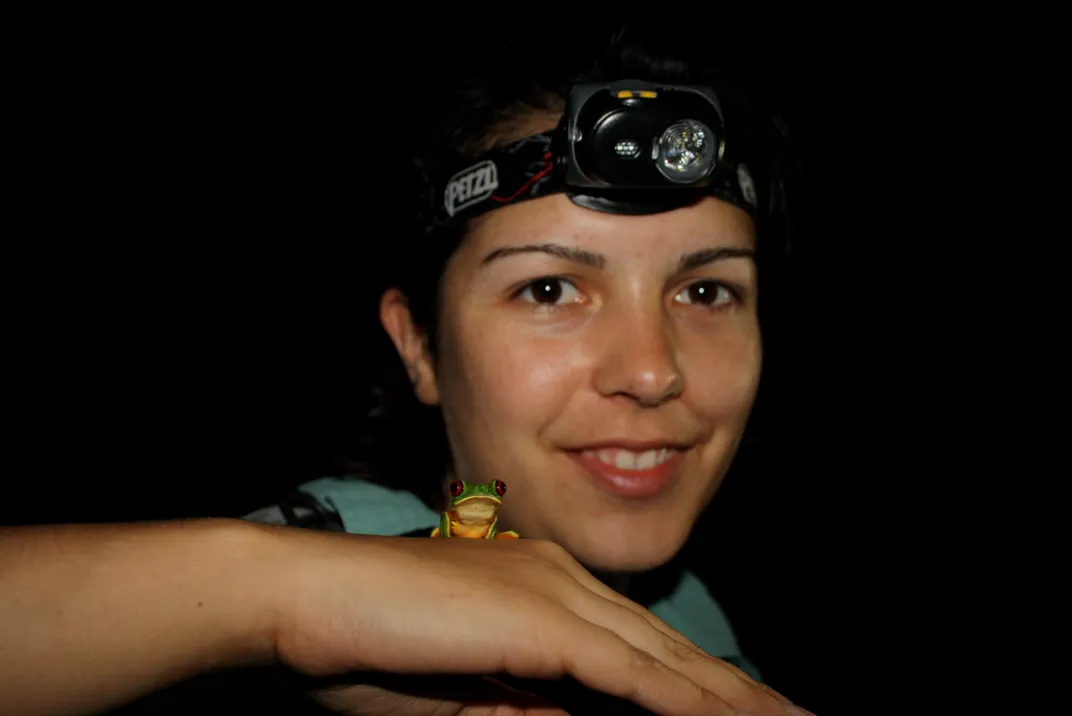The Color-Changing Marvel of Tree Frogs Looking for Love
A new study sheds light on the wild world of “dynamically dichromatic” amphibians
/https://tf-cmsv2-smithsonianmag-media.s3.amazonaws.com/filer/3b/6c/3b6c8ed1-90ae-4dad-a44d-8250be782a40/rayna_bell_-_litoria_revelata-040.jpg)
When seeking out potential mates, frogs, like humans, will often alter their appearance. While humans are generally content to do up their hair and don flattering clothing, amphibians on the make take a more radical approach: they change the color of their skin.
The tree frog family Hylidae contains a diverse array of colorful species. Frogs incapable of color change are termed monochromatic; those that do change color at some point in their life cycle are dichromatic.
Color is important for mating even among monochromatic frogs; the males in monochromatic populations that garner the most attention from the ladies are often the ones with the most striking hues. But the role of color in frog courtship is all the more intriguing in the case of dichromatic specimens.
For some dichromatic frogs, the change in color is irreversible: once sexual maturity hits, the new shade becomes permanent. In the parlance of herpetologists, this type of dichromatism is “ontogenetic.” Most remarkable of all, though, are the frogs exhibiting dynamic dichromatism. They change color every mating season but then revert back to their old selves.
Color change in frogs and its evolutionary significance lie at the heart of a just-released research paper in the Journal of Evolutionary Biology. For lead author Rayna Bell, a research zoologist at the Smithsonian's National Museum of Natural History, the project offered the opportunity to expand on her 2012 survey of frog coloration, and to officially categorize an impressive number of species (178 in all) as dynamically dichromatic based on extensive digging into obscure journal articles, notes and frog photography.
“These Australians saw the [2012] paper and emailed me,” Bell recalls. “And they were like, ‘We’re really interested in this too! And we’ve seen tons of these dynamically dichromatic frogs in Australia, and we’ve been trying to figure out what it means. . . Do you want to team up with us and write a follow-up paper to your first paper?’ So that’s what we’ve been doing ever since.”
It makes intuitive sense that bright colors would be useful for attracting the attention of other frogs. Unfortunately, this comes at the cost of attracting predators as well. For frog species not equipped with chemical poisons, a little discretion is key, and Bell and her team theorize that dynamic dichromatism offers a way for frogs to stand out when they need to—during mating season—but to fade back to a more modest tone after.
By and large, the transformations of Hylidae frogs are toward a bright yellow, but there are several exceptions. The new research cites examples of frogs transitioning to vibrant blue, deep black and bright green.

The observations of Bell and her coauthors homed in on species characterized by “explosive breeding,” in which males tumble over one another searching for females in a rushed, orgiastic spectacle. Whereas many would assume that frog coloration was used strictly as an intersexual signal—males conveying their worthiness to the ladies—Bell’s findings suggest that, in many cases, the vivid mating colors have intrasexual significance. In species characterized by large-scale breeding events, the signal could be more for the benefit of other males—“I am not a female! Keep looking!”—than for the females receiving the onslaught of eligible bachelors.
The researchers’ statistical analysis of the database they created not only shows a correlation between the presence of explosive breeding in tropical frog species and the presence of dynamic dichromatism, but also suggests that the first of these massive breeding events predated the development of the frogs’ color-changing ability. From an evolutionary standpoint, this finding is very exciting to Bell.
“That’s the order you’d expect,” she says, if the hypothesis that the frogs’ dynamic color-changing capability arose as a consequence of their breeding patterns is correct. “If things are correlated,” she notes, “it doesn’t necessarily mean that one thing leads to the other.” But “seeing that order of events was a little bit more compelling. There’s something about the pressures of being able to successfully reproduce in these big groups of breeding frogs—having these colors seems to be advantageous in that social situation.”
Bell acknowledges that “there are definitely more questions than answers at this point.” One of her main goals in spearheading this research was to open the door for other scientists to step in and flesh out her team’s preliminary findings.
Detailed behavioral studies of particular species, she says, would go a long way toward better understanding the practical significance of the color changes, as well as other mysterious frog behaviors such as signaling with the hands and feet. And a more thorough analysis of the endocrinology underlying the Hylidae frogs’ transitions, as well as the limits of frog vision—particularly in low-light conditions, in which many of them live—could make it clearer how large a role color really plays in mating ritual vis-à-vis auditory and other cues.
Bell finds the amorous struggles of frogs a surprisingly relatable subject for human researchers. “It’s interesting to think about the strategies that evolution has come up with to deal with the trials and tribulations of finding a mate,” she says with a laugh. But what really gets her is the wonder of her field, the constant discovery of new species and behaviors. A college herpetology professor opened her eyes to the colossal amount of digging that still has to be done.
“We don’t even know how many kinds of frogs there are, let alone any of this other stuff,” she says. And there’s no replacement for old-fashioned elbow grease when it comes to amphibian research. “If we could recruit some more frog enthusiasts,” she says, “that would be great.”
/https://tf-cmsv2-smithsonianmag-media.s3.amazonaws.com/accounts/headshot/DSC_02399_copy.jpg)
/https://tf-cmsv2-smithsonianmag-media.s3.amazonaws.com/accounts/headshot/DSC_02399_copy.jpg)